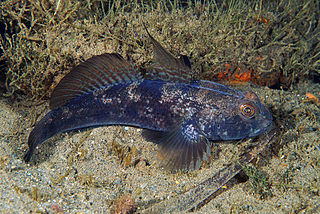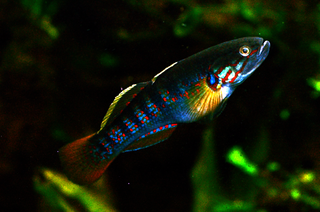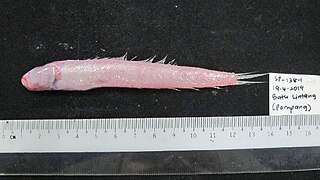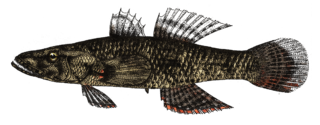
Gobiidae or gobies is a family of bony fish in the order Gobiiformes, one of the largest fish families comprising more than 2,000 species in more than 200 genera. Most of gobiid fish are relatively small, typically less than 10 cm (3.9 in) in length, and the family includes some of the smallest vertebrates in the world, such as Trimmatom nanus and Pandaka pygmaea, Trimmatom nanus are under 1 cm long when fully grown, then Pandaka pygmaea standard length are 9 mm (0.35 in), maximum known standard length are 11 mm (0.43 in). Some large gobies can reach over 30 cm (0.98 ft) in length, but that is exceptional. Generally, they are benthic or bottom-dwellers. Although few are important as food fish for humans, they are of great significance as prey species for other commercially important fish such as cod, haddock, sea bass and flatfish. Several gobiids are also of interest as aquarium fish, such as the dartfish of the genus Ptereleotris. Phylogenetic relationships of gobiids have been studied using molecular data.

Eleotridae is a family of fish commonly known as sleeper gobies, with about 34 genera and 180 species. Most species are found in the tropical Indo-Pacific region, but there are also species in subtropical and temperate regions, warmer parts of the Americas and near the Atlantic coast in Africa. While many eleotrids pass through a planktonic stage in the sea and some spend their entire lives in the sea; as adults, the majority live in freshwater streams and brackish water. One of its genera, Caecieleotris, is troglobitic. They are especially important as predators in the freshwater stream ecosystems on oceanic islands such as New Zealand and Hawaii that otherwise lack the predatory fish families typical of nearby continents, such as catfish. Anatomically, they are similar to the gobies (Gobiidae), though unlike the majority of gobies, they do not have a pelvic sucker.

Mudskippers are any of the 23 extant species of amphibious fish from the subfamily Oxudercinae of the goby family Oxudercidae. They are known for their unusual body shapes, preferences for semiaquatic habitats, limited terrestrial locomotion and jumping, and the ability to survive prolonged periods of time both in and out of water.

The Microdesmidae, the wormfishes and dartfishes, were a family of goby-like fishes in the order Gobiiformes, more recent workers have placed this taxon within the Gobiidae, although the researchers do not define the taxonomic status of this grouping within that family. Two subfamilies in this family were briefly treated as full families - the Ptereleotrinae (dartfishes) and Microdesminae (wormfishes). The family includes about 82 species.

Dartfishes are a group of fish, formerly considered to be a subfamily, Ptereleotrinae, of goby-like fishes in the family Microdesmidae of the order Gobiiformes, Authorities now consider the species in the family Microdesmidae are within the Gobiidae, although the researchers do not define the taxonomic status of this grouping within that family. They are saltwater fish.

Exyrias is a genus of gobies mostly native to marine waters of the Indian Ocean and the western Pacific Ocean with one freshwater species (E. volcanus) known from the Philippines.
Odontamblyopus rebecca is a species of eel goby native to marine and brackish waters of Vietnam. This species can reach a length of 14.1 centimetres (5.6 in) SL. This species is mostly known from several specimens collected from a fish market in Haiphong, Vietnam.

Gobius is a genus of fish in the family Gobiidae native to fresh, brackish and marine waters of and around Europe, Africa and Asia. It contains the typical gobies, being the type genus of the formerly recognised subfamily Gobiinae and family and the namesake genus of its order Gobiiformes.

The Gobiiformes are an order of fish that includes the gobies and their relatives. The order, which was previously considered a suborder of Perciformes, is made up of about 2,211 species that are divided between seven families. Phylogenetic relationships of the Gobiiformes have been elucidated using molecular data. Gobiiforms are primarily small species that live in marine water, but roughly 10% of these species inhabit fresh water. This order is composed chiefly of benthic or burrowing species; like many other benthic fishes, most gobiiforms do not have a gas bladder or any other means of controlling their buoyancy in water, so they must spend most of their time on or near the bottom. Gobiiformes means "goby-like".

Ponticola is a genus of gobies native mostly to fresh waters of the Black Sea - Caspian Sea region in Eurasia. Some species occur in the brackish-water Black and Caspian seas themselves. It was considered to be part of the broader goby subfamily Benthophilinae, also endemic to the same region, although the 5th edition of Fishes of the World does not list any subfamilies in the Gobiidae. Originally, Ponticola was described as subgenus of Neogobius.

The Gobionellinae are a subfamily of fish which was formerly classified in the family Gobiidae, the gobies, but the 5th Edition of Fishes of the World classifies the subfamily as part of the family Oxudercidae. Members of Gobionellinae mostly inhabit estuarine and freshwater habitats; the main exception is the genus Gnatholepis, which live with corals in marine environments. The subfamily is distributed in tropical and temperate regions around the world with the exception of the northeastern Atlantic Ocean, the Mediterranean Sea, and the Ponto-Caspian region. It includes around 370 species and 55 genera: Wikipedia articles about genera list about 389 species.

Oplopomus is a genus of gobies found in coral reefs of the Indo-Pacific region. It contains two species.
Trypauchen vagina, commonly known as the burrowing goby, is a species of eel goby found in the Indo-Pacific region. It has an elongated body about 20 to 22 cm in length. It is reddish-pink in color and possesses distinctive pouches in the upper edges of its gill covers. It lives in burrows in the silty and muddy bottoms of its marine and brackish habitats. It has reduced eyes that are entirely covered with skin and the anterior portion of its head is protected by thick flesh. Both adaptations aid it in digging its burrows.

Trypauchen is a genus of burrowing gobies native to the Indo-Pacific region. It is classified under the subfamily Amblyopinae of the family Gobiidae. The name is derived from Ancient Greek τρύπα and αυχενος, referring to the distinctive opercular pouches of the members of the genus.

Trypauchen pelaeos is a species of eel goby found in Indochina and southern China. It is reddish in color and has an elongated body with the anal, caudal, and the two dorsal fins fused together with membranous structures. It is similar in appearance and habits to the closely related burrowing goby, Trypauchen vagina.

Oxymetopon is a genus of fish formerly classified in the family Microdesmidae but now classified in the Gobiidae. They are native to the western Pacific Ocean. They are sometimes called ribbon-gobies.
Biendongella is a genus of fish in the subfamily Gobionellinae native to the South China Sea. The generic name is formed by adding the diminutive suffix ella to the Vietnamese name for the South China Sea, Bien Dong.
Sovvityazius acer is a species of fish in the family Gobiidae found in the Philippines. This species is the only member of the genus Sovvityazius.

Butidae is a family of sleeper gobies in the order Gobiiformes. The family was formerly classified as a subfamily of the Eleotridae but the 5th Edition of Fishes of the World classifies it as a family in its own right. Molecular phylogenetic analyses have demonstrated that the Butidae are a sister clade to the clade containing the families Gobiidae and Gobionellidae and that the Eleotridae is a sister to both of these clades. This means that the Eloetridae as formerly classified was paraphyletic and that its subfamilies should be raised to the status of families.

Oxudercidae is a family of gobies which consists of four subfamilies which were formerly classified under the family Gobiidae. The family is sometimes called the Gobionellidae, but Oxudercidae has priority. The species in this family have a cosmopolitan distribution in temperate and tropical areas and are found in marine and freshwater environments, typically in inshore, euryhaline areas with silt and sand substrates.















